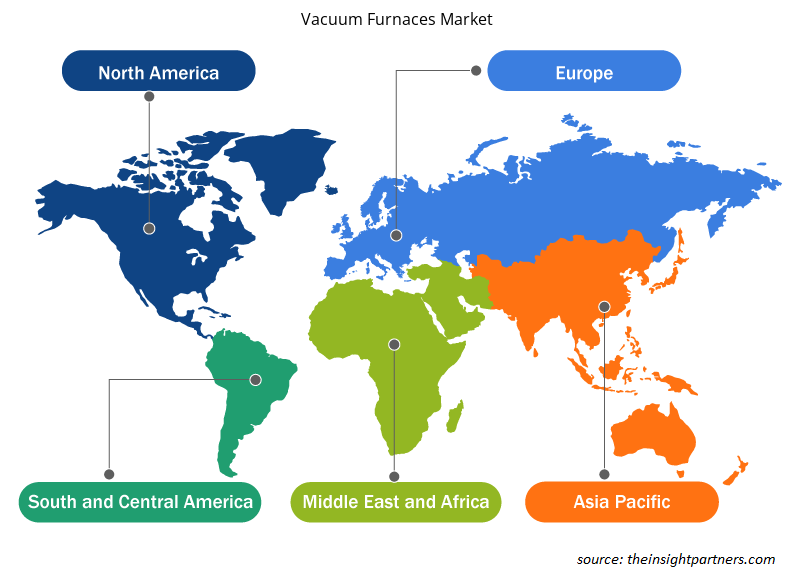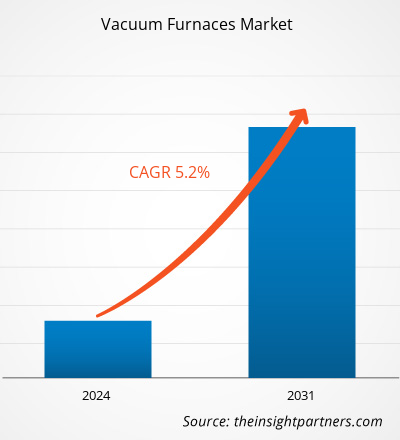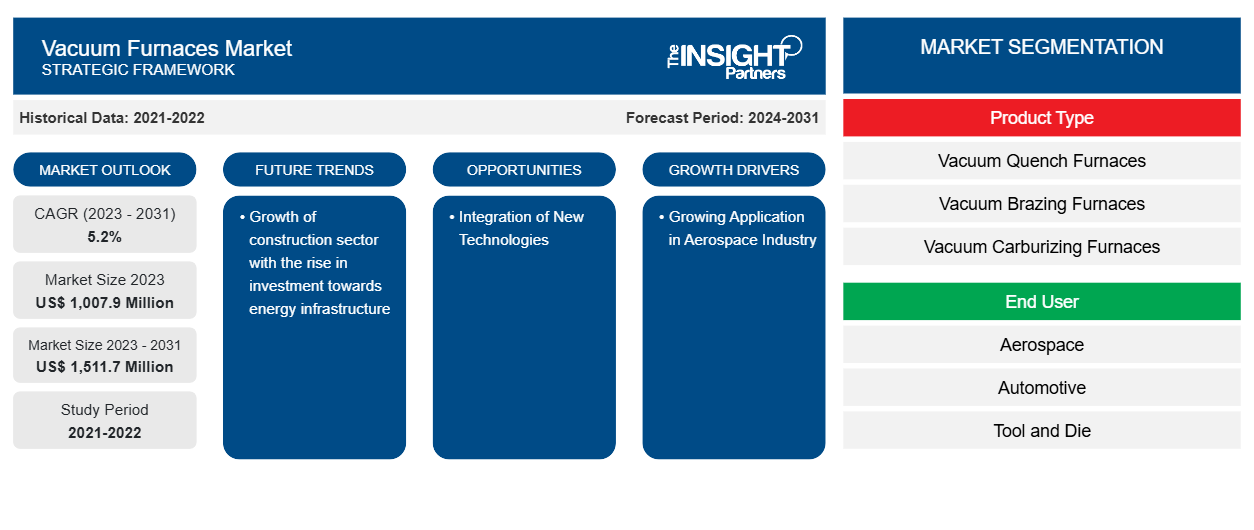La taille du marché des fours à vide devrait atteindre 1 511,7 millions USD d'ici 2031, contre 1 007,9 millions USD en 2023. Le marché devrait enregistrer un TCAC de 5,2 % au cours de la période 2023-2031. La croissance du secteur de la construction avec l'augmentation des investissements dans les infrastructures énergétiques devrait rester l'une des principales tendances du marché.CAGR of 5.2% during 2023–2031. The growth of the construction sector with the rise in investment towards energy infrastructure is likely to remain key trends in the market.
Analyse du marché des fours à vide
L'augmentation de la demande de fours à vide dans les applications industrielles devrait alimenter la croissance du marché dans les années à venir. En outre, l'utilisation croissante de fours à vide dans l'industrie aérospatiale et de la défense devrait alimenter la croissance du marché dans les années à venir. En outre, la croissance du secteur de la construction dans les régions en développement et développées du monde entier et une augmentation des investissements dans les infrastructures électriques pour répondre à la demande en électricité devraient créer des opportunités pour les principaux fabricants de fours à vide de 2023 à 2031.
Aperçu du marché des fours à vide
L'écosystème des fours à vide se compose de trois acteurs majeurs, tels que les fournisseurs de matières premières, les fabricants de fours à vide et les utilisateurs finaux. Les fournisseurs de matières premières comprennent les entreprises qui fournissent diverses matières premières pour l'assemblage et la conception de fours pour l'application souhaitée. Par exemple, certains des principaux types de produits sont les métaux, les actionneurs, les moteurs et les entraînements, entre autres types de produits. Les fabricants de fours à vide collectent des matières premières afin de construire une variété de fours à vide pour diverses applications pour différents secteurs industriels. Les entreprises du secteur des utilisateurs finaux utilisent ces fours à vide pour une variété de produits. La tendance croissante à la structuration des prémoules, l'industrie 4.0, le déploiement de technologies telles que l'IoT et le cloud computing , ainsi que la demande croissante de systèmes d'automatisation efficaces dans toutes les industries sont quelques-uns des facteurs clés qui alimentent la demande de fours à vide.pre-mold structuring, Industry 4.0, deployment of technologies such as IoT and fuelling the demand for vacuum furnaces.
Personnalisez ce rapport en fonction de vos besoins
Vous bénéficierez d'une personnalisation gratuite de n'importe quel rapport, y compris de certaines parties de ce rapport, d'une analyse au niveau des pays, d'un pack de données Excel, ainsi que de superbes offres et réductions pour les start-ups et les universités.
-
Obtenez les principales tendances clés du marché de ce rapport.Cet échantillon GRATUIT comprendra une analyse de données, allant des tendances du marché aux estimations et prévisions.
Facteurs moteurs et opportunités du marché des fours à vide
Une application croissante dans l'industrie aérospatiale pour favoriser le marché
L'industrie aérospatiale est l'un des principaux utilisateurs finaux des fours à vide. Le traitement thermique étant utilisé dans l'industrie aérospatiale pour améliorer la résistance de divers composants à l'usure et à la corrosion, les principales méthodes impliquent le traitement thermique des pièces de moteur soumises à des contraintes et des déformations mécaniques. Comme il offre une grande fiabilité, un encombrement d'installation plus petit et une facilité d'entretien, le traitement thermique au four à vide vertical est utilisé pour chauffer des pièces à section cylindrique ou des pièces empilables verticalement, qui sont couramment traitées dans l'industrie aérospatiale. Les fours à vide sont utilisés pour le brasage, le recuit, le traitement de mise en solution, le vieillissement, le durcissement, le soulagement des contraintes et d'autres traitements thermiques. En conséquence, le marché des fours à vide est en pleine croissance en raison de la large gamme d'applications dans l'industrie aérospatiale.
En outre, l'industrie aérospatiale et de défense (A&D) est engagée dans le développement de nouvelles technologies et solutions, élargissant les perspectives de développement et établissant de nouveaux marchés. Les nouvelles technologies et les nouveaux processus qui évoluent rapidement et sont commercialisés peuvent améliorer l'efficacité et réduire les coûts de production. Les tendances en matière d'augmentation du trafic aérien commercial et de l'activité des commandes des clients sont nettement meilleures qu'avant la COVID-19, ce qui est de bon augure pour l'entreprise. La distribution mondiale de vaccins contre la COVID-19 contribue à la normalisation du transport aérien. Par conséquent, la relance de l'industrie aérospatiale stimule le marché des fours à vide.
Intégration des nouvelles technologies
L'avenir de la technologie de traitement thermique métallurgique est en constante évolution. La technologie des fours à vide est bien connue et utilisée par les industriels de l'ingénierie avec la vision d'établir cette technologie de processus comme un véhicule capable de permettre de nombreuses transformations thermo-métallurgiques innovantes des produits conçus et fabriqués d'aujourd'hui. Selon les tendances internationales existantes et attendues, la technologie des fours à vide a actuellement un potentiel important pour continuer à se développer à l'avenir. C'est une technologie qui permettra à la science des matériaux et à ses partenaires industriels d'entrer facilement dans le troisième millénaire. Par conséquent, la technologie de traitement thermique sous vide joue un rôle essentiel dans le brasage d' alliages d'aluminium non ferreux géométriques complexes
Analyse de segmentation du rapport sur le marché des fours à vide
Les segments clés qui ont contribué à l'élaboration de l'analyse du marché des fours à vide sont le type de produit et l'utilisateur final
- En fonction du type de produit, le marché des fours à vide est divisé en fours de trempe sous vide, fours de brasage sous vide, fours de cémentation sous vide et autres. Le segment des fours de trempe sous vide détenait la plus grande part de marché en 2023.carburizing furnaces, and others. The vacuum quench furnaces segment held the largest market share in 2023.
- En fonction de l'utilisateur final, le marché est classé en aérospatiale, automobile, outillage et matrice, production d'énergie et autres. Le segment aérospatial détenait la plus grande part de marché en 2023.
Analyse des parts de marché des fours à vide par géographie
La portée géographique du rapport sur le marché des fours à vide est principalement divisée en cinq régions : Amérique du Nord, Asie-Pacifique, Europe, Moyen-Orient et Afrique et Amérique du Sud.
Français Le rapport sur le marché des fours à vide couvre l'Amérique du Nord (États-Unis, Canada et Mexique), l'Europe (Allemagne, France, Italie, Espagne, Royaume-Uni et reste de l'Europe), l'Asie-Pacifique (Chine, Inde, Australie, Japon, Corée du Sud et reste de l'Asie-Pacifique), le Moyen-Orient et l'Afrique (Afrique du Sud, Arabie saoudite, Émirats arabes unis et reste du Moyen-Orient et de l'Afrique) et l'Amérique du Sud (Brésil, Argentine et reste de l'Amérique du Sud). En termes de revenus, l'Asie-Pacifique a dominé la part de marché des fours à vide en 2023. L'Europe était le deuxième plus grand contributeur de revenus au marché mondial des fours à vide, suivie de l'Amérique du Nord.UAE, and Rest of Middle East & Africa), and South America (Brazil, Argentina, and the Rest of South America). In terms of revenue, Asia Pacific dominated the vacuum furnaces market share in 2023. Europe was the second-largest revenue contributor to the global vacuum furnaces market, followed by North America.
Aperçu régional du marché des fours à vide
Les tendances et facteurs régionaux influençant le marché des fours à vide tout au long de la période de prévision ont été expliqués en détail par les analystes d’Insight Partners. Cette section traite également des segments et de la géographie du marché des fours à vide en Amérique du Nord, en Europe, en Asie-Pacifique, au Moyen-Orient et en Afrique, ainsi qu’en Amérique du Sud et en Amérique centrale.

- Obtenez les données régionales spécifiques au marché des fours à vide
Portée du rapport sur le marché des fours à vide
| Attribut de rapport | Détails |
|---|---|
| Taille du marché en 2023 | 1 007,9 millions de dollars américains |
| Taille du marché d'ici 2031 | 1 511,7 millions de dollars américains |
| Taux de croissance annuel composé mondial (2023-2031) | 5,2% |
| Données historiques | 2021-2022 |
| Période de prévision | 2024-2031 |
| Segments couverts |
Par type de produit
|
| Régions et pays couverts |
Amérique du Nord
|
| Leaders du marché et profils d'entreprises clés |
|
Densité des acteurs du marché des fours à vide : comprendre son impact sur la dynamique commerciale
Le marché des fours à vide connaît une croissance rapide, tirée par la demande croissante des utilisateurs finaux en raison de facteurs tels que l'évolution des préférences des consommateurs, les avancées technologiques et une plus grande sensibilisation aux avantages du produit. À mesure que la demande augmente, les entreprises élargissent leurs offres, innovent pour répondre aux besoins des consommateurs et capitalisent sur les tendances émergentes, ce qui alimente davantage la croissance du marché.
La densité des acteurs du marché fait référence à la répartition des entreprises ou des sociétés opérant sur un marché ou un secteur particulier. Elle indique le nombre de concurrents (acteurs du marché) présents sur un marché donné par rapport à sa taille ou à sa valeur marchande totale.
Les principales entreprises opérant sur le marché des fours à vide sont :
- AMG Métallurgie avancée
- Technologies du vide ALD
- Industries du vide Centorr
- Chugai RO Co., Ltd.
- Technologies ECM
- HHV Ltée
Avis de non-responsabilité : les sociétés répertoriées ci-dessus ne sont pas classées dans un ordre particulier.

- Obtenez un aperçu des principaux acteurs du marché des fours à vide
Actualités et développements récents du marché des fours à vide
Le marché des fours à vide est évalué en collectant des données qualitatives et quantitatives après des recherches primaires et secondaires, qui comprennent d'importantes publications d'entreprise, des données d'association et des bases de données. Quelques-uns des développements sur le marché des fours à vide sont énumérés ci-dessous :
- HHV et ASM Technologies ont formé une coentreprise pour la fabrication d'équipements pour semi-conducteurs. Les deux sociétés ont formé une coentreprise à 50/50. La nouvelle entité ainsi formée fabriquera des outils, des composants de sous-systèmes et des composants pour les industries des semi-conducteurs et de l'énergie solaire. (Source : HHV Ltd, communiqué de presse, février 2022)
- Ipsen étend ses capacités de service en ajoutant des tests d’épaisseur de paroi par ultrasons pour les fours à vide. Ce test permettrait d’identifier l’intégrité de leurs chambres et d’estimer leur durée de vie en conséquence. (Source : Ipsen, Communiqué de presse, février 2022)
Rapport sur le marché des fours à vide : couverture et livrables
Le rapport « Taille et prévisions du marché des fours à vide (2021-2031) » fournit une analyse détaillée du marché des fours à vide couvrant les domaines ci-dessous :
- Taille et prévisions du marché des fours à vide aux niveaux mondial, régional et national pour tous les segments de marché clés couverts par le champ d'application
- Tendances du marché des fours à vide ainsi que la dynamique du marché telles que les moteurs, les contraintes et les opportunités clés
- Analyse PEST et SWOT détaillée
- Analyse du marché des fours à vide couvrant les principales tendances du marché, le cadre mondial et régional, les principaux acteurs, les réglementations et les développements récents du marché
- Analyse du paysage industriel et de la concurrence couvrant la concentration du marché, l'analyse de la carte thermique, les principaux acteurs et les développements récents pour le marché des fours à vide
- Profils d'entreprise détaillés
- Analyse historique (2 ans), année de base, prévision (7 ans) avec TCAC
- Analyse PEST et SWOT
- Taille du marché Valeur / Volume - Mondial, Régional, Pays
- Industrie et paysage concurrentiel
- Ensemble de données Excel
Rapports récents
Témoignages
Raison d'acheter
- Prise de décision éclairée
- Compréhension de la dynamique du marché
- Analyse concurrentielle
- Connaissances clients
- Prévisions de marché
- Atténuation des risques
- Planification stratégique
- Justification des investissements
- Identification des marchés émergents
- Amélioration des stratégies marketing
- Amélioration de l'efficacité opérationnelle
- Alignement sur les tendances réglementaires























 Obtenez un échantillon gratuit pour - Marché des fours à vide
Obtenez un échantillon gratuit pour - Marché des fours à vide